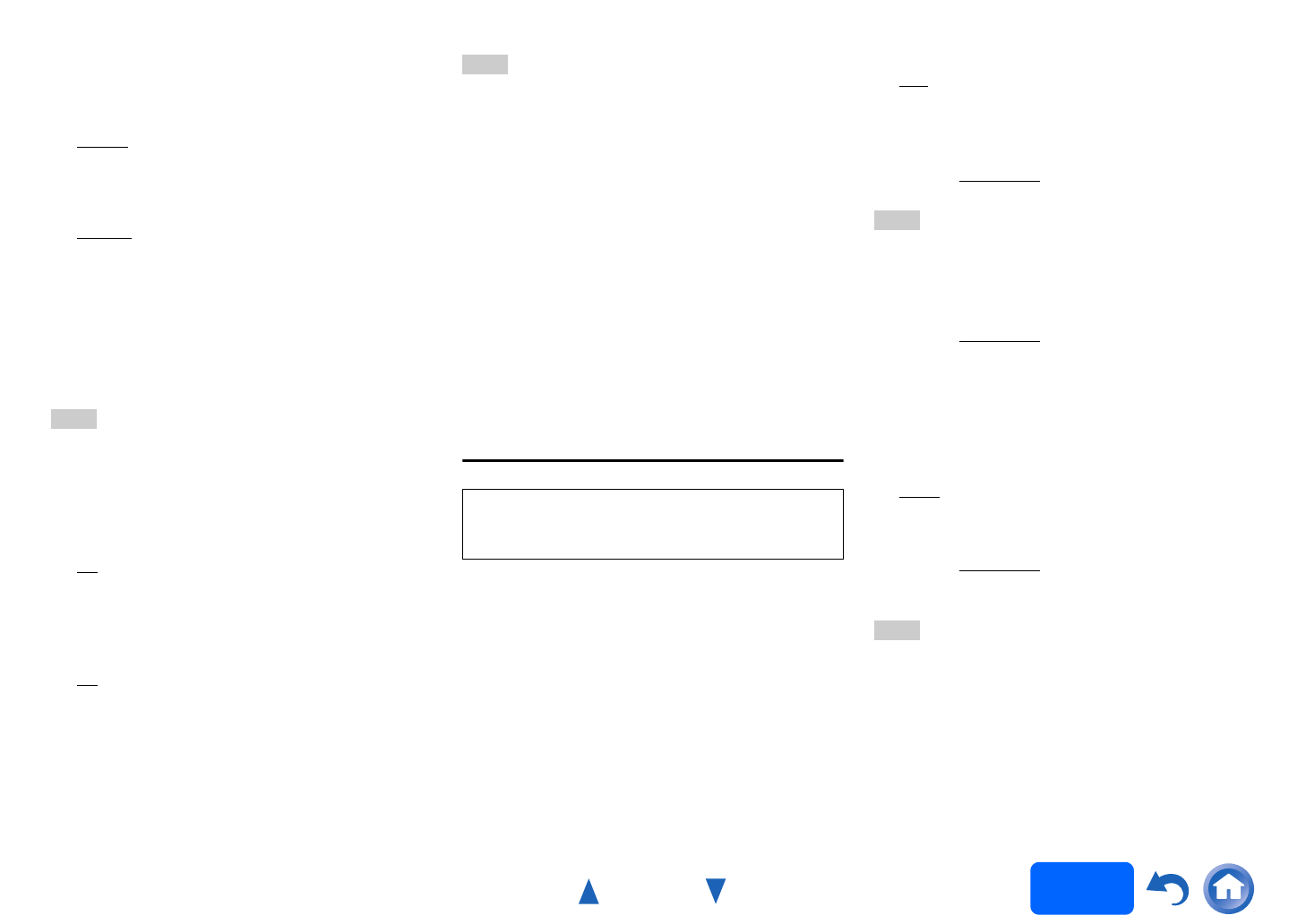
Advanced Operations
En-65
Operating
procedure
(➔ page 61)
■ Speaker Impedance
`4ohms:
Select if the impedance of any speaker is
4 ohms or more but less than 6.
`6ohms
:
Select if the impedances of all speakers are
between 6 and 16 ohms.
■ Speakers Type(Front)
`Normal
:
Select this if you’ve connected your front
speakers normally.
`Bi-Amp:
Select this if you’ve bi-amped your front
speakers.
`Digital Crossover:
Select this if you’re using speakers without
crossover network.
Tip
• If “Speakers Type(Front)” is set to “Digital Crossover”, a
confirmation screen appears. Select “Next (2-7. Digital
Processing Crossover Network)” to display the screen
for Digital Processing Crossover Network (➔ page 68).
Continue with the settings.
■ Powered Zone 2, Powered Zone 3
`No
`Yes:
Zone 2/3 speakers can be used (Powered
Zone 2/3 enabled).
■ 11ch Playback
`No
`Yes
For 11.1-channel playback, set this setting to “Yes”. If
you select front wide speakers setting in Speaker
Configuration is set to “None”, it will be automatically
switched to “80Hz (THX)”.
Note
• Powered Zone 3 is not available in the following cases:
–The “Speakers Type(Front)” setting is set to “Bi-Amp” or
“Digital Crossover”.
–The “Powered Zone 2” setting is set to “No”.
• When the “Powered Zone 3” setting is set to “Yes” while
Powered Zone 2 is enabled (➔ page 84), the surround
back speakers cannot be used.
• When the “Powered Zone 2” setting is set to “Yes”, the
front wide speakers cannot be used.
• When the “Powered Zone 3” setting is set to “Yes”, the
front high speakers cannot be used.
•“11ch Playback” is not available in the following cases:
–The “Speakers Type(Front)” setting is set to “Bi-Amp” or
“Digital Crossover”.
–The “Powered Zone 2” setting is set to “Yes”.
–The “Zone 2 Monitor Out” setting is set to “Use”.
• If the “11ch Playback” setting is set to “Yes”, the audio of
front wide channel is output from FRONT WIDE PRE OUT
only.
Speaker Configuration
With these settings, you can specify which speakers
are connected and a crossover frequency for each
speaker. Specify “Full Band” for speakers that can
output low frequency bass sounds adequately, for
example, speakers with a good sized woofer. For
smaller speakers, specify a crossover frequency.
Sounds below the crossover frequency will be output
by the subwoofer instead of the speaker. Refer to
your speaker’s manuals to determine the optimum
crossover frequencies. If you set up your speakers
using Audyssey MultEQ XT32 Room Correction and
Speaker Setup, please make sure manually that any
THX speakers are set to “80Hz(THX)” crossover.
■ Subwoofer
`Yes
`No
■ Front
`Full Band
`40Hz to 80Hz(THX)
to 100Hz, 120Hz, 150Hz,
200Hz
Note
• If the “Subwoofer” setting is set to “No”, the “Front” setting
is fixed at “Full Band”.
■ Center
*1
, Surround
*1
`Full Band
`40Hz to 80Hz(THX)
to 100Hz, 120Hz, 150Hz,
200Hz
`None
■ Front Wide
*1*2*4*6*7
, Front High
*1*2*5*6
`Full Band
`40Hz to 80Hz(THX) to 100Hz, 120Hz, 150Hz,
200Hz
`None
■ Surround Back
*2*3*8*9
`Full Band
`40Hz to 80Hz(THX)
to 100Hz, 120Hz, 150Hz,
200Hz
`None
Note
*1
“Full Band” can be selected only when “Full Band” is
selected in the “Front” setting.
*2
If the “Surround” setting is set to “None”, this setting
cannot be selected.
*3
If the “Surround” setting is set to anything other than
“Full Band”, “Full Band” cannot be selected here.
*4
When the “Powered Zone 2” setting is set to “Yes”, this
setting cannot be selected.
*5
When the “Powered Zone 3” setting is set to “Yes”, this
setting cannot be selected.
This setting is set automatically by
Audyssey MultEQ
®
XT32 Room Correction and
Speaker Setup function (➔ page 28).


















